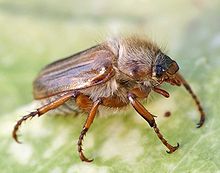| This article needs additional citations for verification. Please help improve this article by adding citations to reliable sources. Unsourced material may be challenged and removed. Find sources: "Amphimallon solstitiale" – news · newspapers · books · scholar · JSTOR (August 2013) (Learn how and when to remove this message) |
| Amphimallon solstitiale | |
|---|---|

| |
| Scientific classification | |
| Domain: | Eukaryota |
| Kingdom: | Animalia |
| Phylum: | Arthropoda |
| Class: | Insecta |
| Order: | Coleoptera |
| Suborder: | Polyphaga |
| Infraorder: | Scarabaeiformia |
| Family: | Scarabaeidae |
| Genus: | Amphimallon |
| Species: | A. solstitiale |
| Binomial name | |
| Amphimallon solstitiale (Linnaeus, 1758) | |
Amphimallon solstitiale, also known as the summer chafer or European june beetle, is a beetle similar to the cockchafer but much smaller, approximately 20 millimetres (0.79 in) in length. They are declining in numbers now, but where found they are often seen in large numbers. At dusk they actively fly around tree tops looking for a mate and can often be found drowning in pools of water the following morning. They are also attracted to light and come in through open, lit windows and fly around lamps, making quite a racket while bumping into lights. They are found throughout the Palearctic region (and North America) and, commonly seen from June to August, living in meadows, hedgerows, and gardens, and eating plants and tree foliage.
The larva of summer chafer undergo a two to three-year period of development underground, feeding upon host plants. Carabid beetles, such as Poecilus cupreus, hunt and consume larvae and serve as a primary predator in arable fields.
These June beetles act as root pests for a number of economically important crops including potatoes, rape, legumes, chestnuts, and turfgrass. As generalist herbivores, they primarily feed upon secondary roots with smaller amounts of anti-herbivore chemicals across many different species. Several chemical and bio-control agents have been developed to control their populations, including their endemic bacteria and entomopathogenic nematodes.
Distribution
The species can be found throughout Europe, extending into Turkey and even occurring in portions of East Asia. A number of other species of Amphimallon have been synonymized with subspecies of A. solstitale, including A. ochraceum and A. irtishensis.
References
- Tolasch, Till; Sölter, Susanne; Tóth, Miklós; Ruther, Joachim; Francke, Wittko (2003-04-01). "(R)-Acetoin-Female Sex Pheromone of the Summer Chafer Amphimallon solstitiale (L.)". Journal of Chemical Ecology. 29 (4): 1045–1050. Bibcode:2003JCEco..29.1045T. doi:10.1023/A:1022992516854. ISSN 1573-1561. PMID 12775160.
- WALDNER, THOMAS; TRAUGOTT, MICHAEL (2012-03-23). "DNA-based analysis of regurgitates: a noninvasive approach to examine the diet of invertebrate consumers". Molecular Ecology Resources. 12 (4): 669–675. doi:10.1111/j.1755-0998.2012.03135.x. ISSN 1755-098X. PMID 22443278.
- Yang, Xing-Zhuo; Zhang, Li; Feng, Run-Qiu; Zhang, Li-Jun; Luo, Fang-Zhen; Yuan, Ming-Long (2019-01-02). "Mitochondrial genome of Amphimallon solstitiale (Coleoptera: Scarabaeidae: Melolonthinae) and phylogenetic analysis". Mitochondrial DNA Part B. 4 (1): 110–111. doi:10.1080/23802359.2018.1536482. ISSN 2380-2359.
- ^ Kazlm, Sezen; Ismail, Demir; Hatice, Katl; Zihni, Demirbag (2005). "Investigations on Bacteria as a Potential Biological Control Agent of Summer Chafer, Amphimallon solstitiale L. (Coleoptera: Scarabaeidae)". Journal of Microbiology. 43 (5): 463–468. ISSN 1225-8873. PMID 16273040.
- ^ "Plant Analysis for Turfgrass", Best Management Practices for Saline and Sodic Turfgrass Soils, CRC Press, pp. 149–164, 2011-09-12, doi:10.1201/b11186-11, ISBN 978-0-429-15019-7, retrieved 2023-10-08
- Tsunoda, Tomonori; Krosse, Sebastian; van Dam, Nicole M. (2017-06-08). "Root and shoot glucosinolate allocation patterns follow optimal defence allocation theory". Journal of Ecology. 105 (5): 1256–1266. Bibcode:2017JEcol.105.1256T. doi:10.1111/1365-2745.12793. ISSN 0022-0477.
- ^ BİRYOL, Seda; EFE, Davut; ESKİ, Ardahan; DEMİRBAĞ, Zihni; DEMİR, İsmail (2020-07-21). "Fungal pathogens of Amphimallon solstitiale Linnaeus, 1758 (Coleoptera: Scarabaeidae)". Turkish Journal of Entomology: 375–384. doi:10.16970/entoted.663690. ISSN 1010-6960.
- Sajnaga, Ewa; Skowronek, Marcin; Kalwasińska, Agnieszka; Kazimierczak, Waldemar; Lis, Magdalena; Jach, Monika Elżbieta; Wiater, Adrian (2022-03-15). "Comparative Nanopore Sequencing-Based Evaluation of the Midgut Microbiota of the Summer Chafer (Amphimallon solstitiale L.) Associated with Possible Resistance to Entomopathogenic Nematodes". International Journal of Environmental Research and Public Health. 19 (6): 3480. doi:10.3390/ijerph19063480. ISSN 1660-4601. PMC 8950650. PMID 35329164.
- "Amphimallon solstitiale (Linnaeus 1758)". 2.6.1. Fauna Europaea. May 24, 2013. Archived from the original on October 11, 2014. Retrieved August 3, 2013.
- Eckehard Rössner, Schwerin; Frank-Thorsten Krell, Denver (2008). "Identität und taxonomischer Status von Amphimallon ochraceum (Knoch, 1801) und A. fallenii (Gyllenhal, 1817) sowie weiterer mit A. solstitiale (Linnaeus, 1758) verwandter Taxa (Coleoptera: Scarabaeidae: Melolonthinae)" (PDF). Veröffentlichungen des Naturkundemuseums Erfurt (In Folge VERNATE). 27: 221–261 – via ZOBODAT.
External links
- [REDACTED] Media related to Amphimallon solstitiale at Wikimedia Commons
- Amphimallon solstitiale page on Encyclopedia of Life
| Taxon identifiers | |
|---|---|
| Amphimallon solstitiale |
|
This Melolonthinae article is a stub. You can help Misplaced Pages by expanding it. |